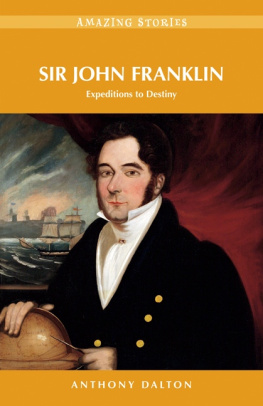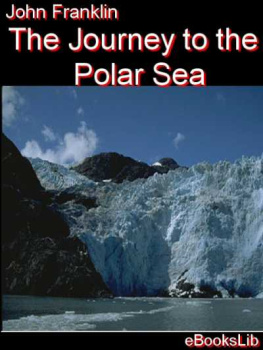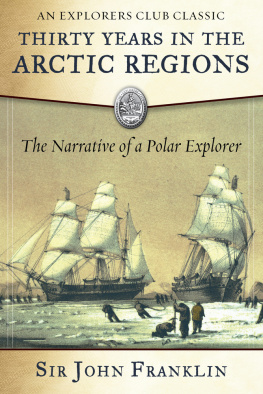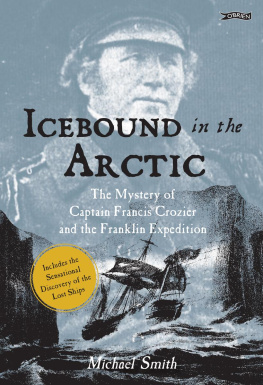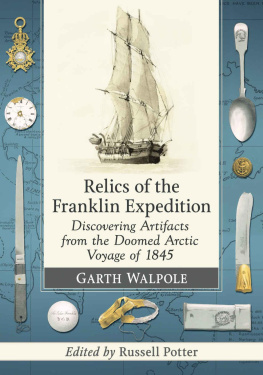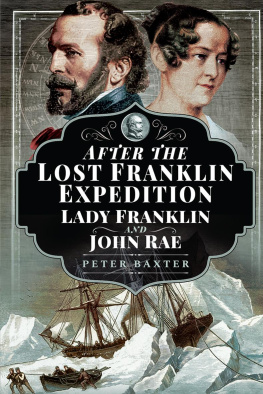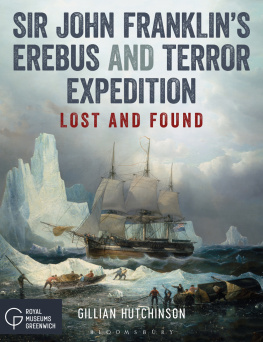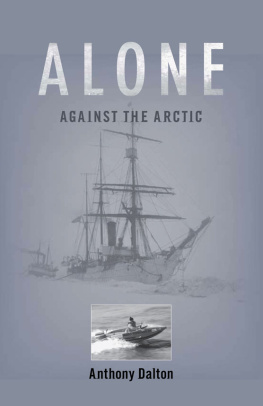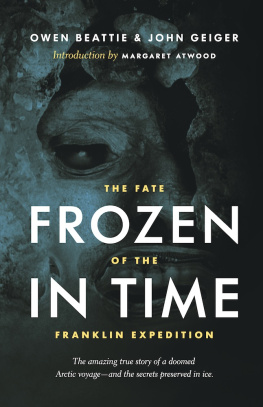CHAPTER
The Boy Sailor
THE ENGLISH COUNTY OF LINCOLNSHIRE is mostly flat, and thanks to the less than perfect climate, it is often damp. There are a few rolling hills, but nothing more imposing than about 131 feet (40 metres) above sea level. There are protective man-made dykes close to the coast and, ranging in from there, large tracts of land devoid of trees. In some ways, it is reminiscent of the North Sea it borders.
John Franklin, who would one day become known as one of the greatest Arctic explorers, was born on this damp Lincolnshire land in the middle of April 1786. He hailed from a small town named Spilsby and went to the local school with Alfred Tennyson, destined eventually to be acclaimed as one of Britains finest poets. The young John Franklin was described by Tennyson as a chubby cherub, round-faced and round-headed. It was, perhaps, an apt description. Most of those features remained with him throughout his life. The son of a prominent businessman, Franklin had seven sisters and an older brother.
Franklins first sight of the sea at the Lincolnshire coast is said to have laid the groundwork for the rest of his life. Although only a boy, he determined to sail the worlds oceans and talked his father into getting him a job on a small freighter operating between nearby Hull, on Englands east coast, and Lisbon, the Portuguese capital. By the end of his first voyage, Franklin knew he wanted to spend his life at sea. At the age of 14, he joined the Royal Navy with the lowly rank of first-class volunteer. Presumably that meant he had to work without pay for a while.
The enthusiastic young sailor was assigned to HMS Polyphemus, under the command of Captain John Lawford, and in March 1801, he set sail for the Baltic Sea and into the Battle of Copenhagen. Second in command of the British fleet at that brief war was the great naval hero Lord Horatio Nelson, then Vice-Admiral, who would later die at Trafalgar. The battle was fought in the straits between Sweden and Denmark and within sight of Kronborg Castle, the setting for William Shakespeares epic play Hamlet. Young John Franklin survived his first action against enemy forces without injury and returned to England safely that summer. Thanks to his fathers influence and his own persistence, he was transferred to HMS Investigator as a midshipman under famed explorer Captain Matthew Flinders. Franklin was perhaps fortunate that Captain Flinders was another Lincolnshire man and also a distant relative.
Investigator, an old and tired ship, was bound for the other side of the world. Flinderss orders were to circumnavigate New Holland, now known as Australia, and to complete a survey of the coastline. The ship sailed away from England at the end of the first week in July 1801 with an excited Midshipman Franklin on board. He would not see his homeland or his family again for just over three years. As a middy, Franklin was classed as a junior officer but still had to sleep in a hammock between decks like an ordinary seaman.
Charged with surveying and scientific duties for the voyage, John Franklin soon made himself popular with Flinders and with his fellow officers. He worked and studied hard and showed a natural ability for making precise astronomical observations. Having Matthew Flinders as a mentor and instructor must have been of huge benefit to the young Franklins education. An added bonus for Franklin was the presence on board of naturalist Robert Brown; the two young men would become firm friends.
The long voyage to the other side of the world was distinguished by two remarkable and tragic events: one of the younger officers and seven men under his command were lost from a small boat close to the Australian coast, and the venerable Investigator was found to be leaking like a sieve and constantly in danger of sinking. But despite the ships unseaworthy condition, Flinders, a master mariner, completed his circumnavigation and made it into Sydney 11 months after leaving England. That was as far as Investigator would go. Unfit for further service at sea, she was condemned to end her days in the harbour as a storage hulk.
With the officers and crew as far away from home as they could possibly be, transport back to England had to be arranged. Captain Flinders, Midshipman John Franklin and a portion of Investigators crew took passage on board HMS Porpoise in August 1803. The naval ship was to travel in convoy with two merchantmen, Cato and Bridgewater. The voyage was a disaster. Six days into the journey, on August 17, Porpoise and Cato ran up onto an uncharted reef off Australias northeast coast at dusk and were wrecked. Bridgewater, perhaps unaware of the calamity, continued on into the gathering darkness of evening. Her own destiny was not far away. She called at a port in the Dutch East Indies before disappearing forever.
Franklin, still only a teenager, had experienced his first shipwreck with the sudden demise of HMS Porpoise. He was among 94 officers and men who survived the accident and fetched up on a bank of coral and sand only 900 feet long by 50 feet wide (274 by 15 metres). Flinders named the piece of land Wreck Reef, for obvious reasons. Part of the Great Barrier Reef, it bears that name to this day. Fortunately for Flinders, Franklin and the remainder of the castaways, a six-oared cutter had somehow escaped unscathed. Flinders and a handful of men embarked on an epic 700-mile (1,127-kilometre) voyage in the small open boat for Sydney, and they made it. It is one of the great small-boat journeys in exploration history. Franklin and the others, meanwhile, had to camp out on the prominent but barren reef and wait for rescue. They did so with good humour, using canvas tents for shelter, and erected a flag pole with an inverted flag to signal their distress.
When Flinders returned for the shipwrecked sailors with three ships, Midshipman Franklin was sent on the first stage of a long voyage home. He boarded the merchantman Rolla, bound for Canton on the south China coast. From there he joined an Indiaman, Earl Camden, one of a fleet of 16 or more merchant ships outbound for England under the command of Commodore Nathaniel Dance of the Honourable East India Company. In mid-February 1804, at the entrance to the Malacca Straits, the lightly armed British ships came under attack by a French naval force of five heavily armed ships led by famed Contre-Admiral Charles-Alexandre Lon Durand, Comte de Linois.
The French war fleet consisted of a 74-gun battle ship, Marengo; two frigates, the 40-gun Belle Poule and the 36-gun Smillante; plus two corvettes carrying 38 guns between them. Against all odds, Dances fleet routed the Frenchmen and continued their voyage. Although there were deaths in the brief fight, Franklin again came through the action unscathed. He reached his home shores in August 1804. He was then 18 years old and a veteran sailor with a long list of adventures behind him, including two sea battles. Much more was to come for the Lincolnshire lad.
During the Napoleonic Wars, Midshipman Franklin served on HMS Bellerophon at the blockade of Brest in 1805, a monotonous duty designed to prevent the French fleet from sailing, and which achieved little else. He was also on Bellerophon at the much more exciting Battle of Trafalgar on October 21, 1805. In that epic battle, 32 British warships took on the combined might of the French and Spanish navies off southern Spains Cape Trafalgar, just to the south of Cadiz.
The British fleet fought in two squadrons, the windward led by Admiral Lord Nelson in HMS Victory and the leeward commanded by Vice-Admiral Collingwood in HMS Royal Sovereign. Victory and Royal Sovereign, out in front of their two squadrons, bore the brunt of the fire from the wide and powerful French and Spanish line.
Next page
